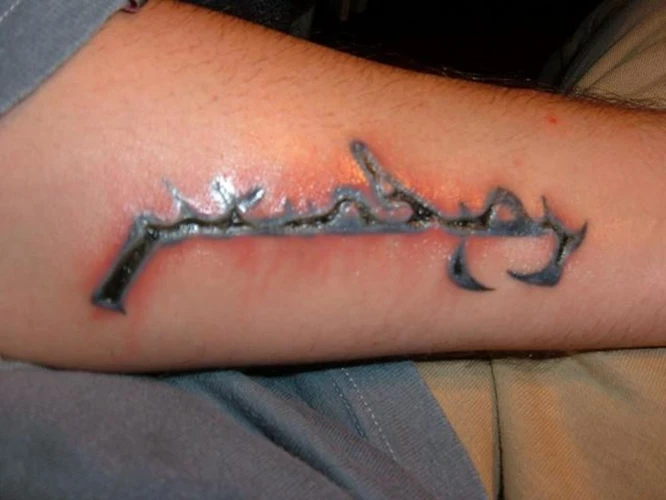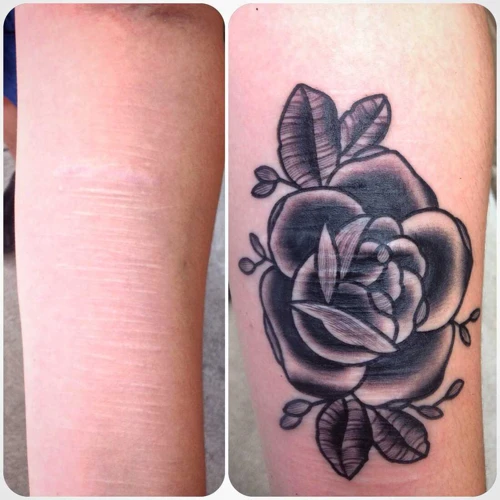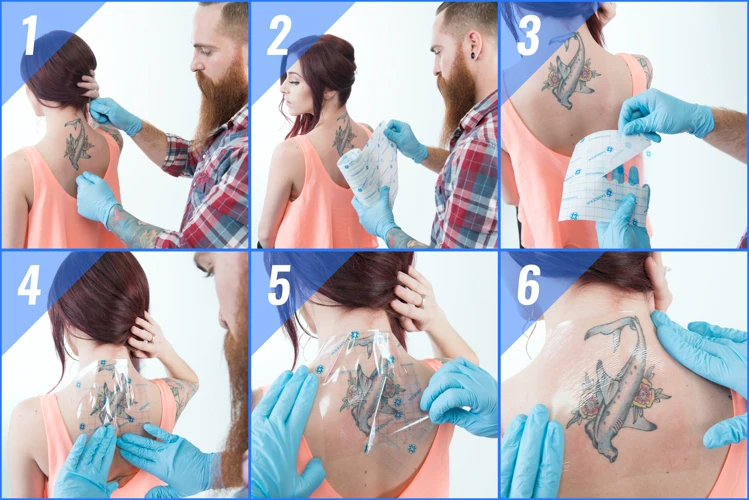If you have recently gotten a tattoo, you may be wondering what happens if you get a cut on it. Although getting a cut on a tattoo is not incredibly common, it is possible and can be uncomfortable and even dangerous. It is important to understand the risks and the tips for prevention when it comes to cuts on tattoos. In this article, we will explore what happens if you get a cut on a tattoo, the risks associated with it, and how to prevent it from happening.
Contents
Causes of Cuts on Tattoos

Scratching
It is important to not scratch your tattoo when it is healing, as this can cause scabs and cuts to form. Scratching can also cause the ink to be removed from the skin, leading to a faded or incomplete tattoo. One of the main reasons why you shouldn’t scratch a tattoo is because it can introduce bacteria to the wound and cause an infection.
Accidents
Accidents can happen, and it is possible to cut your tattoo during everyday activities. Cuts can happen if you accidentally rub against a sharp object, or if you get a snag on a piece of clothing. To help prevent cuts and other damage to your tattoo, be sure to wear loose-fitting clothes and be mindful of any sharp objects.
Scraping
Scraping and abrasion of a tattoo can also lead to cuts and other damage to the tattoo. This is particularly likely to happen if your tattoo is not properly protected by a bandage or other covering. To help protect your tattoo, be sure to cover it with a bandage or other protective covering as directed by your tattoo artist.
Effects of Cuts on Tattoos

Infection
Tattoos are created by injecting ink into the skin, so it’s no surprise that cuts on tattoos can lead to infections. Even if the cut is small, it can put you at risk of infection due to the ink and the tools used to create the tattoo. If you scratch or cut a new tattoo, you are at risk of introducing bacteria into the wound, leading to an infection. Infections can cause redness, swelling, and a pus-like discharge.
Scarring
If you get a cut on a tattoo, it can lead to scarring. This can be difficult to avoid, as the skin is already being stretched and punctured. Cuts on tattoos can cause scarring because the skin is already damaged from the tattooing process. Tattoos that are not cared for properly can also cause scarring.
Slow Healing
Cuts on tattoos can slow down the healing process. This is because the wound is not able to heal properly due to the ink and other materials used in the tattoo process. If you get a cut on a new tattoo, it could take longer for the wound to heal. To speed up the healing process, it is important to take care of your tattoo and keep it clean.
Prevention of Cuts on Tattoos

Moisturize
It is important to keep your skin moisturized to prevent cuts on tattoos. Moisturizing regularly with a tattoo-specific moisturizer will help keep the skin supple and healthy, which will reduce the chances of cuts on tattoos. When moisturizing, it is important to use a product that is formulated for tattoos, as some popular moisturizers may contain ingredients that can irritate and damage the tattoo.
Watch Out for Accidents
Accidents can easily lead to cuts on tattoos. To help prevent cuts on tattoos, be mindful of your surroundings and take extra care when handling sharp objects. Wear protective clothing, such as long sleeves and gloves, to further protect your tattoo from unintentional cuts.
Avoid Scratching
It is important to avoid scratching your tattoo, as this can cause cuts on tattoos. If you find yourself scratching your tattoo, try using a cold compress to help alleviate the itching. Additionally, try to keep your tattoo covered with a bandage or clothing when possible to avoid accidental scratching.
If you do accidentally scratch your new tattoo, it is important to take care of the area immediately. Clean the area with soap and water and apply an antibiotic ointment to help prevent infection. If the cut is deep, it is best to seek medical attention to ensure proper healing.
Treatment for Cuts on Tattoos
Clean the Wound
The first step in treating a cut on your tattoo is to thoroughly wash the wound with warm water and mild, fragrance-free soap. Once the wound is clean, you can use a cotton swab or a clean cloth to gently dab the area with rubbing alcohol or an antiseptic solution. This will help to further clean the wound and reduce the risk of infection.
Apply Antibacterial Ointment
After thoroughly cleansing the wound, you should apply a thin layer of an antibiotic ointment such as Neosporin or Bacitracin. This will help to protect the wound from further infection and promote healing.
Cover the Wound
Finally, you should cover the wound with a sterile bandage. This will help to keep the wound clean and protect it from further injury. It is important to change the bandage daily, or more often if it becomes dirty or wet. If you are concerned about what happens if you accidentally scratch your tattoo, it is important to take precautions to avoid further injury.
Frequently Asked Questions
How can I prevent getting a cut on my tattoo?
- Keep your skin clean: Make sure to wash your tattoo area with lukewarm water and a mild antibacterial soap. Pat dry with a clean towel and apply a thin layer of healing ointment to keep it moisturized.
- Wear protective clothing: Wear clothing that covers your tattoo as much as possible to avoid contact with sharp objects and other irritants.
- Be aware of activities: Avoid activities that could lead to getting a cut on your tattoo, such as playing contact sports or engaging in activities that involve heavy lifting.
- Use a bandage: If you are engaging in activities that could cause a cut, use a bandage to cover the tattoo and protect it from coming into contact with sharp objects.
- Visit a professional: If you are worried about getting a cut on your tattoo, visit a professional tattoo artist to consult and get advice on how to care for your tattoo and prevent cuts.
How should I take care of a cut on my tattoo?
- Clean the wound – Use an antiseptic solution to clean the wound. This will help prevent any infection from occurring.
- Apply an antibiotic ointment – Make sure to only use an antibiotic ointment specifically designed for tattoos. This will help keep the wound clean and protected from any bacteria.
- Keep the area covered – Cover the wound with a bandage or sterile gauze to keep the wound clean and protected.
- Change the bandage regularly – Change the bandage every day or when it becomes dirty or wet. This will help keep the area clean and protected.
- Avoid picking or scratching at the wound – Picking or scratching at the wound can lead to further damage and infection.
- See a doctor if needed – If the wound is deep or is not healing properly, it is important to consult a doctor for further treatment.
Are there any long-term risks associated with a cut on a tattoo?
The long-term risks associated with a cut on a tattoo may include issues such as infection and scarring. Infection can occur if the wound is not properly cleaned and treated afterwards. Even if the wound is treated, it may still result in scarring and discoloration of the tattoo. In addition, the infection may spread to other parts of the body, causing further complications.
What should I do if I Experience Signs of Infection on a Cut on my Tattoo?
Seek medical attention: If you experience signs of infection, such as redness, swelling, pain, or oozing pus, seek medical attention right away.
Clean the wound: Clean the wound with mild soap and water and pat it dry with a clean towel.
Apply an antibiotic ointment: Apply an antibiotic ointment, such as Neosporin, to help prevent infection.
Cover the wound: Cover the wound with a clean, sterile bandage or gauze to help keep it clean and to prevent further infection.
Monitor your symptoms: Monitor your symptoms and watch for signs of infection, such as redness, fever, or pain.
Take medications as prescribed: If prescribed, take antibiotics or antifungal medications as instructed by your doctor.
Avoid touching the area: Avoid touching the area with dirty hands or objects to prevent further infection.
Keep the area dry: Be sure to keep the area clean and dry to prevent further infection.
Stay hydrated: Staying hydrated helps to promote healing.
Is it Safe to Cover a Cut on a Tattoo with a Bandage?
It is not recommended to cover a cut on a tattoo with a bandage as it can trap bacteria and cause an infection. Instead, the cut should be washed with warm water and soap and then left uncovered to allow the wound to breathe. If necessary, a thin layer of Vaseline or vitamin E oil can be applied to the wound to protect it. However, if the wound is deep and requires stitches, it is important to get it treated by a doctor or tattoo artist immediately.
Conclusion
Tattoos are a great way to express yourself, but there is always a risk of infection if the area is not taken care of properly. If a cut is sustained in the tattooed area, it is important to take the necessary steps to ensure proper healing. This includes cleaning the area with soap and water, applying an antiseptic, and keeping the area covered until it is healed. It is also important to take steps to prevent cuts in the first place, such as using sterile needles and avoiding using unsterilized equipment.